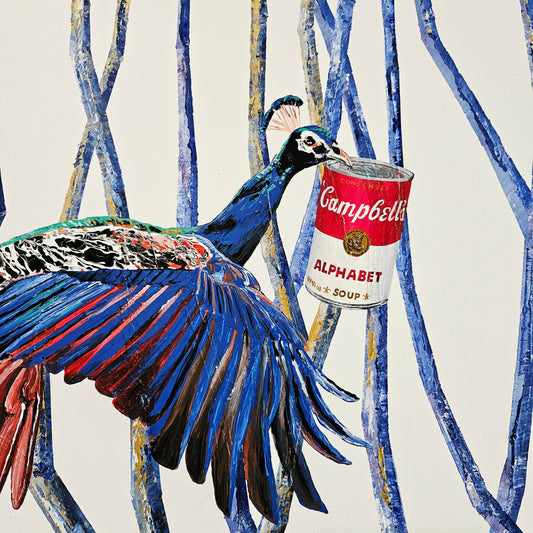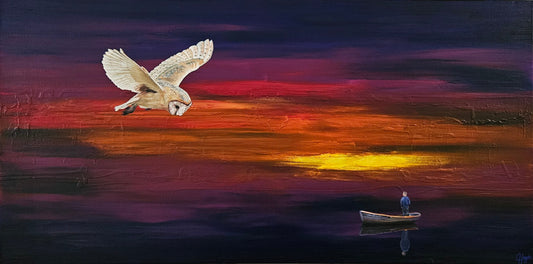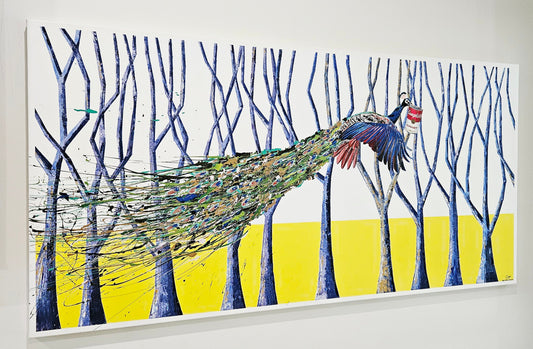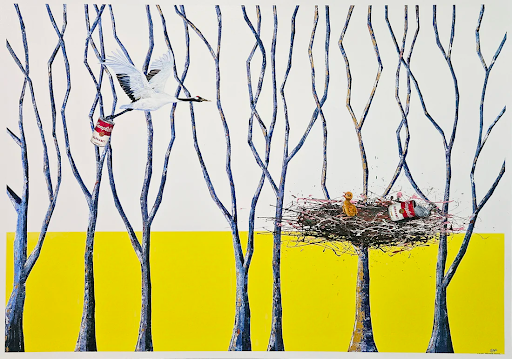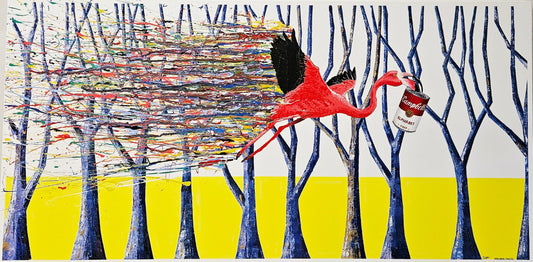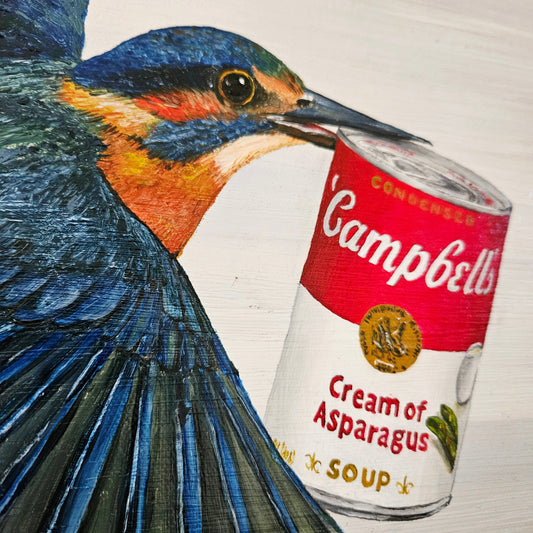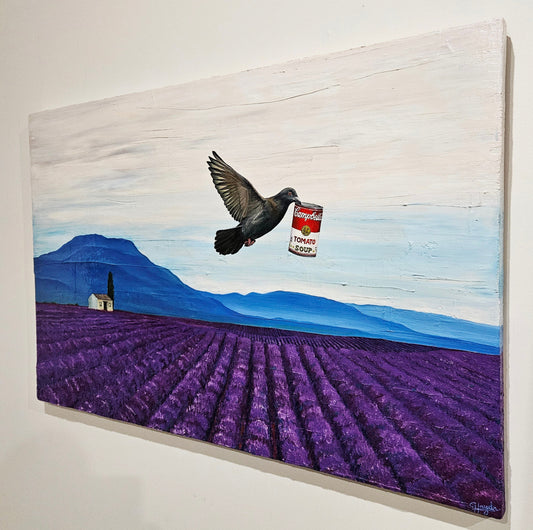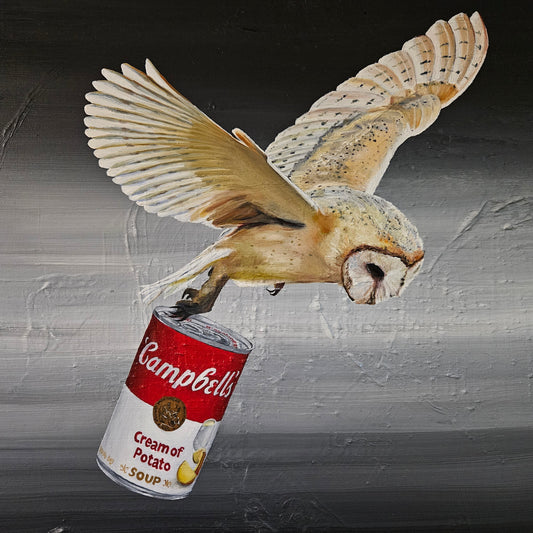Lavender Fields by Haydn: A Surreal Dialogue Between Nature, Culture, and Irony
Lavender Fields by Haydn – A Stunning Surreal Oil Painting Blending Landscape and Pop Art
 Explore Lavender Fields by Haydn, a bold and thought-provoking oil painting that juxtaposes tranquil nature with modern consumer symbolism in a stunning visual and conceptual dialogue.
Explore Lavender Fields by Haydn, a bold and thought-provoking oil painting that juxtaposes tranquil nature with modern consumer symbolism in a stunning visual and conceptual dialogue.
Lavender Fields: A Surreal Conversation Between Beauty, Simplicity, and Consumer Culture
In contemporary art, few works manage to balance both visual beauty and conceptual depth with the same elegance as Lavender Fields by Haydn. This striking oil painting is a masterclass in contrast between landscape and symbolism, serenity and irony, the natural and the artificial.
At first glance, Lavender Fields presents a timeless and poetic rural scene: rows of lush lavender stretch across the foreground, their rich purple hues drawing the eye toward distant, tranquil blue mountains under a pale, endless sky. It is a vision of peace and harmony, deeply rooted in nature’s rhythms.
Yet, almost imperceptibly at first, this traditional vista is interrupted, even challenged by a surreal and unmistakable image: a pigeon flying across the sky, a bright Campbell’s Tomato Soup can clutched in its beak. The deliberate nod to Andy Warhol’s iconic Pop Art throws the entire scene into conceptual tension. This single, ironic element transforms the painting into a layered conversation about art, culture, and the contradictions of modern life.
In this blog, we will explore the various dimensions of Lavender Fields, including its visual composition, symbolism, art historical references, emotional resonance, and its place within Haydn’s broader body of work. We will see why this painting is more than just a beautiful landscape; it is an invitation to think, feel, and question.
The Landscape: Tranquillity and Timelessness
The foundation of Lavender Fields is its breathtakingly serene landscape. Haydn’s deft handling of oil paint creates rows of richly textured lavender that seem to vibrate with life and fragrance. The deep purples of the fields are not merely decorative; they convey a sense of abundance and groundedness, inviting the viewer to almost step into the scene.
Lavender fields themselves are culturally loaded with associations of calm, healing, and timeless beauty. They symbolise the slower pace of rural life, the connection between humanity and the earth, and the pleasures of simplicity. In Haydn’s composition, these fields naturally lead the eye toward distant, blue mountains that rise softly beneath a pale, dreamlike sky.
The sky and mountains, painted with soft, sweeping brushstrokes, evoke a sense of open possibility and depth. The use of pale tones in the sky contrasts beautifully with the vibrancy of the lavender, balancing the composition while reinforcing the feeling of expansive tranquillity.
Nestled in this landscape is a solitary white cottage, positioned low and to the left, flanked by a single dark tree. The cottage is a powerful visual and emotional anchor, a symbol of simplicity, solitude, and domestic life. Its humble presence offers a quiet counterpoint to the vastness around it, reminding us that even in a vast and overwhelming world, small moments of peace and grounding remain possible.
The Pigeon and the Pop Can: Irony in Flight
If Lavender Fields ended there, it would be a superb, if traditional, landscape painting. But Haydn’s true brilliance emerges with the introduction of the painting’s most unexpected and provocative element: a realistically rendered pigeon, soaring across the sky, carrying in its beak a Campbell’s Tomato Soup can.
This deliberate reference to Andy Warhol’s iconic Pop Art injects both humour and conceptual depth into the painting. Warhol’s Campbell’s Soup cans famously challenged the boundaries between high art and consumer culture, turning a mass-produced grocery item into an object of gallery reverence. By placing this symbol within a bucolic natural scene, Haydn creates a jarring yet captivating juxtaposition.
The pigeon, itself a bird long associated with urban life and adaptation, becomes an unlikely messenger, bridging two worlds: the timeless, rural beauty of the lavender fields and the mass-produced, brand-driven landscape of modern consumerism.
Is the bird a bringer of irony? A symbol of intrusion? Or perhaps a playful reminder that in today’s world, even the most idyllic spaces are touched by the inescapable presence of consumer culture?
Haydn offers no explicit answers, which is one of the painting’s greatest strengths. Instead, he invites viewers to sit with the tension, to explore their interpretations, and to consider how nature and culture continually overlap and collide.
The Surreal Tone: Balancing Beauty with Conceptual Play
The genius of Lavender Fields lies in its tone. Despite the introduction of surreal imagery, the painting does not become cynical or chaotic; instead, it remains cohesive and coherent. The landscape retains its grace and harmony, and the pigeon and soup can, though jarring, feel oddly integrated within the dreamlike atmosphere.
This balance is achieved through Haydn’s masterful use of texture, colour, and brushwork. The soft rendering of the sky and mountains creates a space where the boundaries between reality and imagination can blur comfortably. The pigeon is painted with the same technical care as the lavender and cottage, reinforcing the idea that both the natural and the cultural are part of a single, complex world.
The result is a scene that hovers between peaceful pastoralism and postmodern critique. It is both visually stunning and conceptually rich, a painting that can be enjoyed simply for its beauty or explored more deeply for its ideas.
Symbolism and Interpretation
While Haydn leaves much of the painting’s meaning open to interpretation, several themes emerge naturally from its composition:
-
Nature and Consumer Culture
The Campbell’s Soup can, a mass-produced icon, cuts through the timeless rural scene, prompting questions about the encroachment of consumer culture into all aspects of life, even those traditionally seen as pure or untouched. -
Irony and Playfulness
The surreal image of a pigeon carrying a soup can introduces a note of humour, inviting the viewer to engage playfully with the painting while still reflecting on its more profound implications. -
The Tension Between the Rustic and the Modern
The solitary cottage, symbolising simplicity and self-sufficiency, is set against the absurd intrusion of mass-market imagery, highlighting the tension between old ways of life and the inescapable influence of modern consumerism. -
The Role of the Messenger
The pigeon, a bird known for carrying messages, may itself be a metaphor for art’s ability to deliver unexpected insights, or for how modern symbols find their way into even the most unlikely contexts.
Art Historical Context: A Dialogue with Pop Art
By explicitly referencing Andy Warhol’s Pop Art, Haydn places Lavender Fields within a larger art historical conversation.
Pop Art emerged in the mid-20th century as a response to the growing dominance of mass media and consumer goods, challenging traditional notions of what constitutes art. By juxtaposing a Pop Art icon with a conventional landscape, Haydn both honours and critiques this legacy.
He reminds us that art’s dialogue with consumer culture is ongoing, that even as we celebrate nature and simplicity, we are constantly aware of the symbols and products that shape contemporary life.
Emotional Resonance: Beauty Amidst Complexity
Despite its conceptual play, Lavender Fields retains a profound emotional resonance. The lavender fields, the cottage, and the distant mountains offer genuine beauty, peace, and a sense of home. They speak to the human longing for harmony with nature and spaces of quiet reflection.
At the same time, the painting acknowledges that such spaces are never fully insulated from the broader currents of culture and commerce. The pigeon’s flight reminds us that irony and beauty can coexist, and that embracing this complexity is part of engaging with the modern world.
Lavender Fields within Haydn’s Larger Body of Work
Lavender Fields fits beautifully within Haydn’s broader oeuvre, which often explores themes of nature, movement, and human experience through a distinctive blend of realism, abstraction, and surrealism.
As in works like "The Flight" and "The Search," Haydn here captures a moment of motion and transformation. However, in Lavender Fields, the conceptual layer is even more pronounced, inviting viewers not only to feel but also to think, to reflect on the intersections between art, culture, and the environment.
An Invitation to See Anew
Lavender Fields is more than an artwork. It is an experience, a visual and intellectual journey that rewards repeated viewing and contemplation.
It reminds us that beauty is never simple, that irony can enrich rather than diminish aesthetic pleasure, and that art remains one of the most powerful means of exploring the complexities of the world we inhabit.
By blending the poetry of nature with the language of Pop Art, Haydn has created a work that speaks to both the heart and the mind. Whether viewed as a celebration of landscape, a playful critique of consumer culture, or a meditation on modern life’s contradictions, Lavender Fields leaves an indelible impression.
In the end, it invites us, much like the pigeon soaring across its sky, to carry our questions and insights forward, navigating the space where tradition and modernity, simplicity and complexity, coexist and collide.

